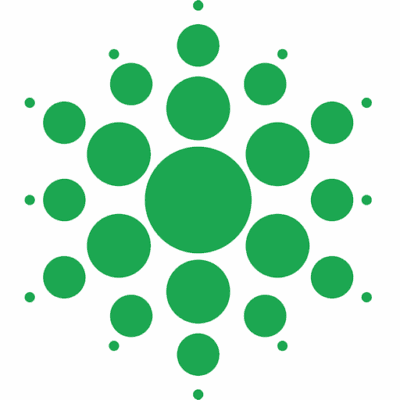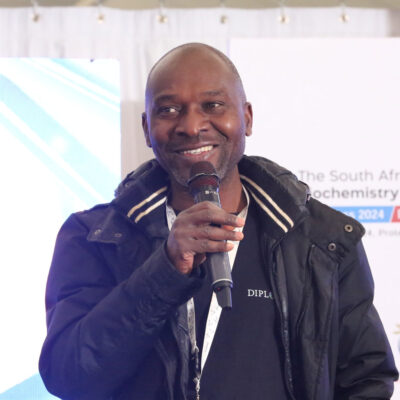About
Addmore Shonhai is Professor of Biochemistry at the University of Venda in South Africa. He received his BSc Honours degree in Applied Biology & Biochemistry from the National University of Science & Technology (NUST) in Zimbabwe. He subsequently worked in the pharmaceutical and biotechnology industries before studying for a PhD in Biochemistry at Rhodes University in South Africa. His PhD was supervised by Professor Greg Blatch formerly Pro-Vice Chancellor, at Notre Dame University, Freemantle Campus, Australia, and now semi-retired. Subsequently, he conducted postdoctoral studies in Greg Blatch’s laboratory before his appointment as a lecturer in the department of Biochemistry & Microbiology at Zululand University in South Africa.
Prof. Shonhai’s area of research involves understanding the role of heat shock proteins in the development of infectious agents. Another area of interest involves using heat shock proteins as biotechnological tools to enhance recombinant protein production in E. coli. He is also interested in the prospects of using synthetic gold nanoparticles as artificial molecular chaperones.
Prof. Shonhai is a current council member of the South African Society of Biochemistry & Molecular Biology (SASBMB). This is a second term of service in this regard having been a SASBMB council member previously from 2011-2018. He has previously served as convenor of the rating panel of the National Research Foundation (NRF) of South Africa overseeing the rating process of scientists within the Biochemistry, Molecular and Cell Biology (BIOC) cluster.
To date, Prof. Shonhai has received research funding totalling approximately ZAR20 million from various organizations such as the Germany Research Foundation (DFG), South African Medical Research Council (SAMRC), International Centre for Genetic Engineering and Biotechnology (ICGEB) and the NRF of South Africa. He is a recipient of a prestigious Georg Foster Fellowship, awarded to him by the Alexander von Humboldt Foundation of Germany. He is lifetime member of the Cell Stress International Society.
Selected recent publications
1485676
{1485676:IAU574QK},{1485676:3C3PSC2E},{1485676:JEHA3M8R},{1485676:6TVDZR6I},{1485676:SM8T9N9L},{1485676:PUPKTF4H},{1485676:Q753ZDRZ},{1485676:I8DKTYHR}
1
nature
50
date
1
350
https://biophysicsworkshop.co.za/wp-content/plugins/zotpress/
%7B%22status%22%3A%22success%22%2C%22updateneeded%22%3Afalse%2C%22instance%22%3Afalse%2C%22meta%22%3A%7B%22request_last%22%3A0%2C%22request_next%22%3A0%2C%22used_cache%22%3Atrue%7D%2C%22data%22%3A%5B%7B%22key%22%3A%223C3PSC2E%22%2C%22library%22%3A%7B%22id%22%3A1485676%7D%2C%22meta%22%3A%7B%22creatorSummary%22%3A%22Kayamba%20et%20al.%22%2C%22parsedDate%22%3A%222024-10-08%22%2C%22numChildren%22%3A1%7D%2C%22bib%22%3A%22%26lt%3Bdiv%20class%3D%26quot%3Bcsl-bib-body%26quot%3B%20style%3D%26quot%3Bline-height%3A%202%3B%20%26quot%3B%26gt%3B%5Cn%20%20%26lt%3Bdiv%20class%3D%26quot%3Bcsl-entry%26quot%3B%20style%3D%26quot%3Bclear%3A%20left%3B%20%26quot%3B%26gt%3B%5Cn%20%20%20%20%26lt%3Bdiv%20class%3D%26quot%3Bcsl-left-margin%26quot%3B%20style%3D%26quot%3Bfloat%3A%20left%3B%20padding-right%3A%200.5em%3B%20text-align%3A%20right%3B%20width%3A%201em%3B%26quot%3B%26gt%3B1.%26lt%3B%5C%2Fdiv%26gt%3B%26lt%3Bdiv%20class%3D%26quot%3Bcsl-right-inline%26quot%3B%20style%3D%26quot%3Bmargin%3A%200%20.4em%200%201.5em%3B%26quot%3B%26gt%3BKayamba%2C%20F.%20%26lt%3Bi%26gt%3Bet%20al.%26lt%3B%5C%2Fi%26gt%3B%20A%20promising%20class%20of%20Antiprotozoal%20agents%2C%20design%20and%20synthesis%20of%20novel%20Pyrimidine%26%23×2013%3BCinnamoyl%20Hybrids.%20%26lt%3Bi%26gt%3BEuropean%20Journal%20of%20Medicinal%20Chemistry%26lt%3B%5C%2Fi%26gt%3B%20116944%20%282024%29%20%26lt%3Ba%20class%3D%26%23039%3Bzp-DOIURL%26%23039%3B%20href%3D%26%23039%3Bhttp%3A%5C%2F%5C%2Fdoi.org%5C%2F10.1016%5C%2Fj.ejmech.2024.116944%26%23039%3B%26gt%3Bhttp%3A%5C%2F%5C%2Fdoi.org%5C%2F10.1016%5C%2Fj.ejmech.2024.116944%26lt%3B%5C%2Fa%26gt%3B.%20%26lt%3Ba%20title%3D%26%23039%3BCite%20in%20RIS%20Format%26%23039%3B%20class%3D%26%23039%3Bzp-CiteRIS%26%23039%3B%20data-zp-cite%3D%26%23039%3Bapi_user_id%3D1485676%26amp%3Bitem_key%3D3C3PSC2E%26%23039%3B%20href%3D%26%23039%3Bjavascript%3Avoid%280%29%3B%26%23039%3B%26gt%3BCite%26lt%3B%5C%2Fa%26gt%3B%20%26lt%3B%5C%2Fdiv%26gt%3B%5Cn%20%20%26lt%3B%5C%2Fdiv%26gt%3B%5Cn%26lt%3B%5C%2Fdiv%26gt%3B%22%2C%22data%22%3A%7B%22itemType%22%3A%22journalArticle%22%2C%22title%22%3A%22A%20promising%20class%20of%20Antiprotozoal%20agents%2C%20design%20and%20synthesis%20of%20novel%20Pyrimidine%5Cu2013Cinnamoyl%20Hybrids%22%2C%22creators%22%3A%5B%7B%22creatorType%22%3A%22author%22%2C%22firstName%22%3A%22Francis%22%2C%22lastName%22%3A%22Kayamba%22%7D%2C%7B%22creatorType%22%3A%22author%22%2C%22firstName%22%3A%22Rajshekhar%22%2C%22lastName%22%3A%22Karpoormath%22%7D%2C%7B%22creatorType%22%3A%22author%22%2C%22firstName%22%3A%22Vincent%20A.%22%2C%22lastName%22%3A%22Obakachi%22%7D%2C%7B%22creatorType%22%3A%22author%22%2C%22firstName%22%3A%22Mavela%22%2C%22lastName%22%3A%22Mahlalela%22%7D%2C%7B%22creatorType%22%3A%22author%22%2C%22firstName%22%3A%22Danny%22%2C%22lastName%22%3A%22Banda%22%7D%2C%7B%22creatorType%22%3A%22author%22%2C%22firstName%22%3A%22Robyn%20L.%22%2C%22lastName%22%3A%22van%20Zyl%22%7D%2C%7B%22creatorType%22%3A%22author%22%2C%22firstName%22%3A%22Sahil%22%2C%22lastName%22%3A%22Lala%22%7D%2C%7B%22creatorType%22%3A%22author%22%2C%22firstName%22%3A%22Tawanda%22%2C%22lastName%22%3A%22Zininga%22%7D%2C%7B%22creatorType%22%3A%22author%22%2C%22firstName%22%3A%22Addmore%22%2C%22lastName%22%3A%22Shonhai%22%7D%2C%7B%22creatorType%22%3A%22author%22%2C%22firstName%22%3A%22Baji%20Baba%22%2C%22lastName%22%3A%22Shaik%22%7D%2C%7B%22creatorType%22%3A%22author%22%2C%22firstName%22%3A%22Ofentse%20J.%22%2C%22lastName%22%3A%22Pooe%22%7D%5D%2C%22abstractNote%22%3A%22Malaria%2C%20caused%20by%20parasitic%20protozoans%20of%20the%20Plasmodium%20genus%2C%20continues%20to%20be%20one%20of%20the%20greatest%20global%20health%20crises%2C%20especially%20in%20Africa.%20The%20emergence%20of%20antimalarial%20drug%20resistance%20continues%20to%20be%20a%20health%20problem%20necessitating%20an%20urgent%20need%20for%20alternative%20and%20cost-effective%20antimalarials.%20Using%20a%20molecular%20hybridization%20approach%2C%20we%20report%20the%20design%20and%20synthesis%20of%20an%20efficacious%20novel%20class%20of%20antiprotozoal%20agents%3B%20%28E%29-1-%284-%284%2C6-diphenylpyrimidin-2-yl%29piperazin-1-yl%29-3-phenyl%20prop-2-en-1-one%20derivatives%20%288a-r%29.%20The%20in%20vitro%20inhibitory%20activity%20of%20the%20synthesized%20compounds%20was%20evaluated%20against%20the%20NF54%20chloroquine-sensitive%20strain%20of%20Plasmodium%20falciparum.%20From%20the%20antiprotozoal%20screening%2C%20three%20compounds%20displayed%20propitious%20activity%20with%20IC50%20values%20%280.18-0.21%5Cu03bcM%29%2C%20using%20quinine%20and%20chloroquine%20as%20standard%20antimalarials.%20Compounds%208o%20and%208l%20emerged%20as%20the%20most%20potent%20candidates%20with%20IC50%20values%20of%200.18%20%5Cu00b1%200.02%20%5Cu03bcM%20and%200.21%20%5Cu00b1%200.001%20%5Cu03bcM%20with%20an%20associated%20good%20safety%20index%20of%2018.59%20and%2016.75%20to%20human%20kidney%20epithelial%20%28HEK293%29%20cells%2C%20respectively.%20The%20synthesized%20analogues%20present%20a%20new%20chemical%20architecture%20structurally%20unrelated%20to%20the%20current%20regime%20of%20antimalarial%20drugs%2C%20representing%20a%20valid%20strategy%20to%20combat%20resistance%20in%20P.%20falciparum%20species%20to%20current%20commercial%20drugs.%20We%20further%20investigated%20the%20binding%20affinities%20of%20the%20compounds%20against%20recombinant%20forms%20of%20two%20P.%20falciparum%20heat%20shock%20protein%2070%20homologues%3B%20PfHsp70-1%20and%20PfHsp70-z%2C%20both%20of%20which%20are%20essential%20and%20promising%20druggable%20candidates.%20Compound%208l%20exhibited%20the%20highest%20binding%20affinity%20for%20both%20PfHsp70s.%20Furthermore%2C%20molecular%20docking%20revealed%20that%20compounds%208k%2C%208l%2C%208m%2C%20and%208o%20exhibited%20better%20fitness%20to%20PfHsp70-1%2C%20with%20compounds%208l%20and%208o%20showing%20the%20highest%20binding%20affinity%20of%2010.5%20kcal%5C%2Fmol%20and%2010.1%20kcal%5C%2Fmol%2C%20respectively.%20Therefore%2C%20it%20can%20be%20speculated%20that%20PfHsp70-1%20may%20be%20a%20possible%20target%20of%20some%20of%20the%20inhibitors%20tested%20in%20this%20study.%20The%20presence%20of%20electron-donating%20groups%20on%20the%20phenyl%20ring%20of%204%2C6-pyrimidine%20moiety%20and%20cinnamoyl%20group%20demonstrated%20a%20positive%20correlation%20between%20the%20observed%20computational%20data%20and%20the%20biological%20activity.%20Taken%20together%2C%20this%20paper%20demonstrates%20the%20importance%20of%20using%20the%20molecular%20hybridization%20approach%20in%20the%20development%20of%20newer%20cinnamoyl%20clubbed%20with%204%2C6-diphenyl%20pyrimidine%20hybrids%20as%20potential%20antiprotozoal%20agents.%22%2C%22date%22%3A%222024-10-08%22%2C%22language%22%3A%22%22%2C%22DOI%22%3A%2210.1016%5C%2Fj.ejmech.2024.116944%22%2C%22ISSN%22%3A%220223-5234%22%2C%22url%22%3A%22https%3A%5C%2F%5C%2Fwww.sciencedirect.com%5C%2Fscience%5C%2Farticle%5C%2Fpii%5C%2FS0223523424008250%22%2C%22collections%22%3A%5B%22EENXQ3XN%22%5D%2C%22dateModified%22%3A%222024-11-03T18%3A16%3A14Z%22%7D%7D%2C%7B%22key%22%3A%22I8DKTYHR%22%2C%22library%22%3A%7B%22id%22%3A1485676%7D%2C%22meta%22%3A%7B%22creatorSummary%22%3A%22Nndwammbi%20et%20al.%22%2C%22parsedDate%22%3A%222024-07-01%22%2C%22numChildren%22%3A0%7D%2C%22bib%22%3A%22%26lt%3Bdiv%20class%3D%26quot%3Bcsl-bib-body%26quot%3B%20style%3D%26quot%3Bline-height%3A%202%3B%20%26quot%3B%26gt%3B%5Cn%20%20%26lt%3Bdiv%20class%3D%26quot%3Bcsl-entry%26quot%3B%20style%3D%26quot%3Bclear%3A%20left%3B%20%26quot%3B%26gt%3B%5Cn%20%20%20%20%26lt%3Bdiv%20class%3D%26quot%3Bcsl-left-margin%26quot%3B%20style%3D%26quot%3Bfloat%3A%20left%3B%20padding-right%3A%200.5em%3B%20text-align%3A%20right%3B%20width%3A%201em%3B%26quot%3B%26gt%3B1.%26lt%3B%5C%2Fdiv%26gt%3B%26lt%3Bdiv%20class%3D%26quot%3Bcsl-right-inline%26quot%3B%20style%3D%26quot%3Bmargin%3A%200%20.4em%200%201.5em%3B%26quot%3B%26gt%3BNndwammbi%2C%20A.%20A.%20T.%20%26lt%3Bi%26gt%3Bet%20al.%26lt%3B%5C%2Fi%26gt%3B%20Ursolic%20acid%20acetate%20and%20iso-mukaadial%20acetate%20bind%20to%20Plasmodium%20falciparum%20Hsp90%2C%20abrogating%20its%20chaperone%20function%20in%20vitro.%20%26lt%3Bi%26gt%3BNaunyn-Schmiedeberg%26%23×2019%3Bs%20Arch%20Pharmacol%26lt%3B%5C%2Fi%26gt%3B%20%26lt%3Bb%26gt%3B397%26lt%3B%5C%2Fb%26gt%3B%2C%205179%26%23×2013%3B5192%20%282024%29.%20%26lt%3Ba%20title%3D%26%23039%3BCite%20in%20RIS%20Format%26%23039%3B%20class%3D%26%23039%3Bzp-CiteRIS%26%23039%3B%20data-zp-cite%3D%26%23039%3Bapi_user_id%3D1485676%26amp%3Bitem_key%3DI8DKTYHR%26%23039%3B%20href%3D%26%23039%3Bjavascript%3Avoid%280%29%3B%26%23039%3B%26gt%3BCite%26lt%3B%5C%2Fa%26gt%3B%20%26lt%3B%5C%2Fdiv%26gt%3B%5Cn%20%20%26lt%3B%5C%2Fdiv%26gt%3B%5Cn%26lt%3B%5C%2Fdiv%26gt%3B%22%2C%22data%22%3A%7B%22itemType%22%3A%22journalArticle%22%2C%22title%22%3A%22Ursolic%20acid%20acetate%20and%20iso-mukaadial%20acetate%20bind%20to%20Plasmodium%20falciparum%20Hsp90%2C%20abrogating%20its%20chaperone%20function%20in%20vitro%22%2C%22creators%22%3A%5B%7B%22creatorType%22%3A%22author%22%2C%22firstName%22%3A%22Andani%20A.%20T.%22%2C%22lastName%22%3A%22Nndwammbi%22%7D%2C%7B%22creatorType%22%3A%22author%22%2C%22firstName%22%3A%22Tendamudzimu%20Harmfree%22%2C%22lastName%22%3A%22Dongola%22%7D%2C%7B%22creatorType%22%3A%22author%22%2C%22firstName%22%3A%22Addmore%22%2C%22lastName%22%3A%22Shonhai%22%7D%2C%7B%22creatorType%22%3A%22author%22%2C%22firstName%22%3A%22Fortunate%22%2C%22lastName%22%3A%22Mokoena%22%7D%2C%7B%22creatorType%22%3A%22author%22%2C%22firstName%22%3A%22Ofentse%20J.%22%2C%22lastName%22%3A%22Pooe%22%7D%2C%7B%22creatorType%22%3A%22author%22%2C%22firstName%22%3A%22Mthokozisi%20B.%20C.%22%2C%22lastName%22%3A%22Simelane%22%7D%5D%2C%22abstractNote%22%3A%22Plasmodium%20falciparum%20is%20the%20most%20lethal%20malaria%20parasite.%20Increasing%20incidences%20of%20drug%20resistance%20of%20P.%20falciparum%20have%20prompted%20the%20need%20for%20discovering%20new%20and%20effective%20antimalarial%20compounds%20with%20an%20alternative%20mode%20of%20action.%20Heat%20shock%20protein%2090%20%28PfHsp90%29%20facilitates%20protein%20folding%20and%20is%20a%20promising%20antimalarial%20drug%20target.%20We%20have%20previously%20reported%20that%20iso-mukaadial%20acetate%20%28IMA%29%20and%20ursolic%20acid%20acetate%20%28UAA%29%20exhibit%20antimalarial%20activity.%20We%20investigated%20the%20abilities%20of%20IMA%20and%20UAA%20to%20bind%20PfHsp90%20by%20molecular%20docking%20and%20dynamics%20simulations.%20The%20in%20silico%20predictions%20were%20validated%20by%20biochemical%20assays%20conducted%20on%20recombinant%20PfHsp90.%20The%20interaction%20between%20the%20ligands%20and%20PfHsp90%20was%20evaluated%20using%20ultraviolet-visible%20spectroscopy%20%28UV-vis%29%2C%20Fourier%20transform%20infrared%20%28FTIR%29%2C%20and%20surface%20plasmon%20resonance%20%28SPR%29%20analysis.%20The%20results%20obtained%20by%20docking%20calculations%20and%20MD%20dynamics%20simulation%20predicted%20that%20UAA%20and%20IMA%20preferentially%20bound%20to%20PfHsp90%20via%20the%20N-terminal%20domain%2C%20with%20UAA%20binding%20more%20stable%20than%20IMA.%20UV-vis-based%20data%20suggest%20that%20PfHsp90%20harbors%20buried%20aromatic%20amino%20acids%2C%20which%20were%20exposed%20in%20the%20presence%20of%20either%20IMA%20or%20UAA.%20In%20addition%2C%20data%20obtained%20using%20FTIR%20suggested%20that%20IMA%20and%20UAA%20destabilized%20the%20secondary%20structure%20of%20PfHsp90.%20Of%20the%20two%20compounds%2C%20UAA%20bound%20to%20PfHsp90%20within%20the%20micromolar%20range%20based%20on%20surface%20plasmon%20resonance%20%28SPR%29-based%20binding%20assay.%20Furthermore%2C%20both%20compounds%20disrupted%20the%20holdase%20chaperone%20function%20of%20PfHsp90%20as%20the%20chaperone%20failed%20to%20suppress%20heat-induced%20aggregation%20of%20the%20model%20proteins%2C%20malate%20dehydrogenase%20%28MDH%29%2C%20luciferase%2C%20and%20citrate%20synthase%20in%20vitro.%20In%20addition%2C%20both%20compounds%20lowered%20the%20ATPase%20activity%20of%20PfHsp90.%20The%20molecular%20dynamics%20simulation%20analysis%20indicated%20that%20the%20docked%20complexes%20were%20mostly%20stable%20for%20100%20ns%2C%20validating%20the%20data%20obtained%20through%20the%20biochemical%20assays.%20Altogether%2C%20this%20study%20expands%20the%20repository%20of%20antiplasmodial%20compounds%20that%20have%20PfHsp90%20among%20their%20possible%20targets.%22%2C%22date%22%3A%222024-07-01%22%2C%22language%22%3A%22en%22%2C%22DOI%22%3A%2210.1007%5C%2Fs00210-024-02944-9%22%2C%22ISSN%22%3A%221432-1912%22%2C%22url%22%3A%22https%3A%5C%2F%5C%2Fdoi.org%5C%2F10.1007%5C%2Fs00210-024-02944-9%22%2C%22collections%22%3A%5B%22EENXQ3XN%22%5D%2C%22dateModified%22%3A%222024-11-03T18%3A15%3A32Z%22%7D%7D%2C%7B%22key%22%3A%22IAU574QK%22%2C%22library%22%3A%7B%22id%22%3A1485676%7D%2C%22meta%22%3A%7B%22creatorSummary%22%3A%22Ahmad%20et%20al.%22%2C%22parsedDate%22%3A%222024-04-01%22%2C%22numChildren%22%3A0%7D%2C%22bib%22%3A%22%26lt%3Bdiv%20class%3D%26quot%3Bcsl-bib-body%26quot%3B%20style%3D%26quot%3Bline-height%3A%202%3B%20%26quot%3B%26gt%3B%5Cn%20%20%26lt%3Bdiv%20class%3D%26quot%3Bcsl-entry%26quot%3B%20style%3D%26quot%3Bclear%3A%20left%3B%20%26quot%3B%26gt%3B%5Cn%20%20%20%20%26lt%3Bdiv%20class%3D%26quot%3Bcsl-left-margin%26quot%3B%20style%3D%26quot%3Bfloat%3A%20left%3B%20padding-right%3A%200.5em%3B%20text-align%3A%20right%3B%20width%3A%201em%3B%26quot%3B%26gt%3B1.%26lt%3B%5C%2Fdiv%26gt%3B%26lt%3Bdiv%20class%3D%26quot%3Bcsl-right-inline%26quot%3B%20style%3D%26quot%3Bmargin%3A%200%20.4em%200%201.5em%3B%26quot%3B%26gt%3BAhmad%2C%20T.%20%26lt%3Bi%26gt%3Bet%20al.%26lt%3B%5C%2Fi%26gt%3B%20%26lt%3Bi%26gt%3BPlasmodium%20falciparum%26lt%3B%5C%2Fi%26gt%3B%20heat%20shock%20proteins%20as%20antimalarial%20drug%20targets%3A%20An%20update.%20%26lt%3Bi%26gt%3BCell%20Stress%20and%20Chaperones%26lt%3B%5C%2Fi%26gt%3B%20%26lt%3Bb%26gt%3B29%26lt%3B%5C%2Fb%26gt%3B%2C%20326%26%23×2013%3B337%20%282024%29.%20%26lt%3Ba%20title%3D%26%23039%3BCite%20in%20RIS%20Format%26%23039%3B%20class%3D%26%23039%3Bzp-CiteRIS%26%23039%3B%20data-zp-cite%3D%26%23039%3Bapi_user_id%3D1485676%26amp%3Bitem_key%3DIAU574QK%26%23039%3B%20href%3D%26%23039%3Bjavascript%3Avoid%280%29%3B%26%23039%3B%26gt%3BCite%26lt%3B%5C%2Fa%26gt%3B%20%26lt%3B%5C%2Fdiv%26gt%3B%5Cn%20%20%26lt%3B%5C%2Fdiv%26gt%3B%5Cn%26lt%3B%5C%2Fdiv%26gt%3B%22%2C%22data%22%3A%7B%22itemType%22%3A%22journalArticle%22%2C%22title%22%3A%22%3Ci%3EPlasmodium%20falciparum%3C%5C%2Fi%3E%20heat%20shock%20proteins%20as%20antimalarial%20drug%20targets%3A%20An%20update%22%2C%22creators%22%3A%5B%7B%22creatorType%22%3A%22author%22%2C%22firstName%22%3A%22Tanveer%22%2C%22lastName%22%3A%22Ahmad%22%7D%2C%7B%22creatorType%22%3A%22author%22%2C%22firstName%22%3A%22Bushra%20A.%22%2C%22lastName%22%3A%22Alhammadi%22%7D%2C%7B%22creatorType%22%3A%22author%22%2C%22firstName%22%3A%22Shaikha%20Y.%22%2C%22lastName%22%3A%22Almaazmi%22%7D%2C%7B%22creatorType%22%3A%22author%22%2C%22firstName%22%3A%22Sahar%22%2C%22lastName%22%3A%22Arafa%22%7D%2C%7B%22creatorType%22%3A%22author%22%2C%22firstName%22%3A%22Gregory%20L.%22%2C%22lastName%22%3A%22Blatch%22%7D%2C%7B%22creatorType%22%3A%22author%22%2C%22firstName%22%3A%22Tanima%22%2C%22lastName%22%3A%22Dutta%22%7D%2C%7B%22creatorType%22%3A%22author%22%2C%22firstName%22%3A%22Jason%20E.%22%2C%22lastName%22%3A%22Gestwicki%22%7D%2C%7B%22creatorType%22%3A%22author%22%2C%22firstName%22%3A%22Robert%20A.%22%2C%22lastName%22%3A%22Keyzers%22%7D%2C%7B%22creatorType%22%3A%22author%22%2C%22firstName%22%3A%22Addmore%22%2C%22lastName%22%3A%22Shonhai%22%7D%2C%7B%22creatorType%22%3A%22author%22%2C%22firstName%22%3A%22Harpreet%22%2C%22lastName%22%3A%22Singh%22%7D%5D%2C%22abstractNote%22%3A%22Global%20efforts%20to%20eradicate%20malaria%20are%20threatened%20by%20multiple%20factors%2C%20particularly%20the%20emergence%20of%20antimalarial%20drug%20resistant%20strains%20of%20Plasmodium%20falciparum.%20Heat%20shock%20proteins%20%28HSPs%29%2C%20particularly%20P.%20falciparum%20HSPs%20%28PfHSPs%29%2C%20represent%20promising%20drug%20targets%20due%20to%20their%20essential%20roles%20in%20parasite%20survival%20and%20virulence%20across%20the%20various%20life%20cycle%20stages.%20Despite%20structural%20similarities%20between%20human%20and%20malarial%20HSPs%20posing%20challenges%2C%20there%20is%20substantial%20evidence%20for%20subtle%20differences%20that%20could%20be%20exploited%20for%20selective%20drug%20targeting.%20This%20review%20provides%20an%20update%20on%20the%20potential%20of%20targeting%20various%20PfHSP%20families%20%28particularly%20PfHSP40%2C%20PfHSP70%2C%20and%20PfHSP90%29%20and%20their%20interactions%20within%20PfHSP%20complexes%20as%20a%20strategy%20to%20develop%20new%20antimalarial%20drugs.%20In%20addition%2C%20the%20need%20for%20a%20deeper%20understanding%20of%20the%20role%20of%20HSP%20complexes%20at%20the%20host%5Cu2013parasite%20interface%20is%20highlighted%2C%20especially%20heterologous%20partnerships%20between%20human%20and%20malarial%20HSPs%2C%20as%20this%20opens%20novel%20opportunities%20for%20targeting%20protein%5Cu2013protein%20interactions%20crucial%20for%20malaria%20parasite%20survival%20and%20pathogenesis.%22%2C%22date%22%3A%222024-04-01%22%2C%22language%22%3A%22%22%2C%22DOI%22%3A%2210.1016%5C%2Fj.cstres.2024.03.007%22%2C%22ISSN%22%3A%221355-8145%22%2C%22url%22%3A%22https%3A%5C%2F%5C%2Fwww.sciencedirect.com%5C%2Fscience%5C%2Farticle%5C%2Fpii%5C%2FS1355814524000592%22%2C%22collections%22%3A%5B%22EENXQ3XN%22%5D%2C%22dateModified%22%3A%222024-11-03T18%3A16%3A16Z%22%7D%7D%2C%7B%22key%22%3A%22Q753ZDRZ%22%2C%22library%22%3A%7B%22id%22%3A1485676%7D%2C%22meta%22%3A%7B%22creatorSummary%22%3A%22Dongola%20et%20al.%22%2C%22parsedDate%22%3A%222024-01-01%22%2C%22numChildren%22%3A1%7D%2C%22bib%22%3A%22%26lt%3Bdiv%20class%3D%26quot%3Bcsl-bib-body%26quot%3B%20style%3D%26quot%3Bline-height%3A%202%3B%20%26quot%3B%26gt%3B%5Cn%20%20%26lt%3Bdiv%20class%3D%26quot%3Bcsl-entry%26quot%3B%20style%3D%26quot%3Bclear%3A%20left%3B%20%26quot%3B%26gt%3B%5Cn%20%20%20%20%26lt%3Bdiv%20class%3D%26quot%3Bcsl-left-margin%26quot%3B%20style%3D%26quot%3Bfloat%3A%20left%3B%20padding-right%3A%200.5em%3B%20text-align%3A%20right%3B%20width%3A%201em%3B%26quot%3B%26gt%3B1.%26lt%3B%5C%2Fdiv%26gt%3B%26lt%3Bdiv%20class%3D%26quot%3Bcsl-right-inline%26quot%3B%20style%3D%26quot%3Bmargin%3A%200%20.4em%200%201.5em%3B%26quot%3B%26gt%3BDongola%2C%20T.%20H.%20%26lt%3Bi%26gt%3Bet%20al.%26lt%3B%5C%2Fi%26gt%3B%20Insertion%20of%20GGMP%20repeat%20residues%20of%20%26lt%3Bi%26gt%3BPlasmodium%20falciparum%26lt%3B%5C%2Fi%26gt%3B%20Hsp70-1%20in%20the%20lid%20of%20DnaK%20adversely%20impacts%20client%20recognition.%20%26lt%3Bi%26gt%3BInternational%20Journal%20of%20Biological%20Macromolecules%26lt%3B%5C%2Fi%26gt%3B%20%26lt%3Bb%26gt%3B255%26lt%3B%5C%2Fb%26gt%3B%2C%20128070%20%282024%29.%20%26lt%3Ba%20title%3D%26%23039%3BCite%20in%20RIS%20Format%26%23039%3B%20class%3D%26%23039%3Bzp-CiteRIS%26%23039%3B%20data-zp-cite%3D%26%23039%3Bapi_user_id%3D1485676%26amp%3Bitem_key%3DQ753ZDRZ%26%23039%3B%20href%3D%26%23039%3Bjavascript%3Avoid%280%29%3B%26%23039%3B%26gt%3BCite%26lt%3B%5C%2Fa%26gt%3B%20%26lt%3B%5C%2Fdiv%26gt%3B%5Cn%20%20%26lt%3B%5C%2Fdiv%26gt%3B%5Cn%26lt%3B%5C%2Fdiv%26gt%3B%22%2C%22data%22%3A%7B%22itemType%22%3A%22journalArticle%22%2C%22title%22%3A%22Insertion%20of%20GGMP%20repeat%20residues%20of%20%3Ci%3EPlasmodium%20falciparum%3C%5C%2Fi%3E%20Hsp70-1%20in%20the%20lid%20of%20DnaK%20adversely%20impacts%20client%20recognition%22%2C%22creators%22%3A%5B%7B%22creatorType%22%3A%22author%22%2C%22firstName%22%3A%22Tendamudzimu%20Harmfree%22%2C%22lastName%22%3A%22Dongola%22%7D%2C%7B%22creatorType%22%3A%22author%22%2C%22firstName%22%3A%22Graham%22%2C%22lastName%22%3A%22Chakafana%22%7D%2C%7B%22creatorType%22%3A%22author%22%2C%22firstName%22%3A%22Caitlin%22%2C%22lastName%22%3A%22Middlemiss%22%7D%2C%7B%22creatorType%22%3A%22author%22%2C%22firstName%22%3A%22Ofentse%22%2C%22lastName%22%3A%22Mafethe%22%7D%2C%7B%22creatorType%22%3A%22author%22%2C%22firstName%22%3A%22Fortunate%22%2C%22lastName%22%3A%22Mokoena%22%7D%2C%7B%22creatorType%22%3A%22author%22%2C%22firstName%22%3A%22Tawanda%22%2C%22lastName%22%3A%22Zininga%22%7D%2C%7B%22creatorType%22%3A%22author%22%2C%22firstName%22%3A%22Addmore%22%2C%22lastName%22%3A%22Shonhai%22%7D%5D%2C%22abstractNote%22%3A%22Although%20Hsp70%20is%20a%20conserved%20molecular%20chaperone%2C%20it%20exhibits%20some%20degree%20of%20functional%20specialisation%20across%20species.%20Features%20of%20Hsp70%20regulating%20its%20functional%20specialisation%20remain%20to%20be%20fully%20established.%20We%20previously%20demonstrated%20that%20E.%20coli%20Hsp70%20%28DnaK%29%20exhibits%20functional%20features%20that%20distinguishes%20it%20from%20PfHsp70-1%2C%20a%20canonical%20cytosolic%20Hsp70%20of%20Plasmodium%20falciparum.%20One%20of%20the%20defining%20features%20of%20PfHsp70-1%20is%20that%20it%20possesses%20GGMP%20repeat%20residues%20located%20in%20its%20C-terminal%20lid%20segment%2C%20while%20DnaK%20lacks%20this%20motif.%20Previously%2C%20we%20demonstrated%20that%20the%20insertion%20of%20GGMP%20repeat%20residues%20of%20PfHsp70-1%20into%20E.%20coli%20DnaK%20abrogates%20the%20chaperone%20activity%20of%20DnaK.%20However%2C%20the%20role%20of%20the%20GGMP%20motif%20in%20regulating%20Hsp70%20function%20remains%20to%20be%20fully%20understood.%20To%20explore%20the%20function%20of%20this%20motif%2C%20we%20expressed%20recombinant%20forms%20of%20wild%20type%20DnaK%20and%20its%20GGMP%20insertion%20motif%2C%20DnaK-G%20and%20systematically%20characterised%20the%20structure-function%20features%20of%20the%20two%20proteins%20using%20in%20silico%20analysis%2C%20biophysical%20approaches%20and%20an%20in%20cellulo%20complementation%20assay.%20Our%20findings%20demonstrated%20that%20the%20GGMP%20inserted%20in%20DnaK%20compromised%20various%20functional%20features%20such%20as%20nucleotide%20binding%2C%20allostery%2C%20substrate%20binding%20affinity%20and%20cellular%20proteome%20client%20selectivity.%20These%20findings%20thus%2C%20highlight%20the%20GGMP%20motif%20of%20Hsp70%20as%20an%20important%20functional%20module.%22%2C%22date%22%3A%222024-01-01%22%2C%22language%22%3A%22%22%2C%22DOI%22%3A%2210.1016%5C%2Fj.ijbiomac.2023.128070%22%2C%22ISSN%22%3A%220141-8130%22%2C%22url%22%3A%22https%3A%5C%2F%5C%2Fwww.sciencedirect.com%5C%2Fscience%5C%2Farticle%5C%2Fpii%5C%2FS0141813023049693%22%2C%22collections%22%3A%5B%22EENXQ3XN%22%5D%2C%22dateModified%22%3A%222024-11-03T18%3A15%3A58Z%22%7D%7D%2C%7B%22key%22%3A%22PUPKTF4H%22%2C%22library%22%3A%7B%22id%22%3A1485676%7D%2C%22meta%22%3A%7B%22creatorSummary%22%3A%22Mafethe%20et%20al.%22%2C%22parsedDate%22%3A%222023-10-17%22%2C%22numChildren%22%3A0%7D%2C%22bib%22%3A%22%26lt%3Bdiv%20class%3D%26quot%3Bcsl-bib-body%26quot%3B%20style%3D%26quot%3Bline-height%3A%202%3B%20%26quot%3B%26gt%3B%5Cn%20%20%26lt%3Bdiv%20class%3D%26quot%3Bcsl-entry%26quot%3B%20style%3D%26quot%3Bclear%3A%20left%3B%20%26quot%3B%26gt%3B%5Cn%20%20%20%20%26lt%3Bdiv%20class%3D%26quot%3Bcsl-left-margin%26quot%3B%20style%3D%26quot%3Bfloat%3A%20left%3B%20padding-right%3A%200.5em%3B%20text-align%3A%20right%3B%20width%3A%201em%3B%26quot%3B%26gt%3B1.%26lt%3B%5C%2Fdiv%26gt%3B%26lt%3Bdiv%20class%3D%26quot%3Bcsl-right-inline%26quot%3B%20style%3D%26quot%3Bmargin%3A%200%20.4em%200%201.5em%3B%26quot%3B%26gt%3BMafethe%2C%20O.%20%26lt%3Bi%26gt%3Bet%20al.%26lt%3B%5C%2Fi%26gt%3B%20Pharmacophore%20Model-Based%20Virtual%20Screening%20Workflow%20for%20Discovery%20of%20Inhibitors%20Targeting%20Plasmodium%20falciparum%20Hsp90.%20%26lt%3Bi%26gt%3BACS%20Omega%26lt%3B%5C%2Fi%26gt%3B%20%26lt%3Bb%26gt%3B8%26lt%3B%5C%2Fb%26gt%3B%2C%2038220%26%23×2013%3B38232%20%282023%29.%20%26lt%3Ba%20title%3D%26%23039%3BCite%20in%20RIS%20Format%26%23039%3B%20class%3D%26%23039%3Bzp-CiteRIS%26%23039%3B%20data-zp-cite%3D%26%23039%3Bapi_user_id%3D1485676%26amp%3Bitem_key%3DPUPKTF4H%26%23039%3B%20href%3D%26%23039%3Bjavascript%3Avoid%280%29%3B%26%23039%3B%26gt%3BCite%26lt%3B%5C%2Fa%26gt%3B%20%26lt%3B%5C%2Fdiv%26gt%3B%5Cn%20%20%26lt%3B%5C%2Fdiv%26gt%3B%5Cn%26lt%3B%5C%2Fdiv%26gt%3B%22%2C%22data%22%3A%7B%22itemType%22%3A%22journalArticle%22%2C%22title%22%3A%22Pharmacophore%20Model-Based%20Virtual%20Screening%20Workflow%20for%20Discovery%20of%20Inhibitors%20Targeting%20Plasmodium%20falciparum%20Hsp90%22%2C%22creators%22%3A%5B%7B%22creatorType%22%3A%22author%22%2C%22firstName%22%3A%22Ofentse%22%2C%22lastName%22%3A%22Mafethe%22%7D%2C%7B%22creatorType%22%3A%22author%22%2C%22firstName%22%3A%22Tlhalefo%22%2C%22lastName%22%3A%22Ntseane%22%7D%2C%7B%22creatorType%22%3A%22author%22%2C%22firstName%22%3A%22Tendamudzimu%20Harmfree%22%2C%22lastName%22%3A%22Dongola%22%7D%2C%7B%22creatorType%22%3A%22author%22%2C%22firstName%22%3A%22Addmore%22%2C%22lastName%22%3A%22Shonhai%22%7D%2C%7B%22creatorType%22%3A%22author%22%2C%22firstName%22%3A%22Njabulo%20Joyfull%22%2C%22lastName%22%3A%22Gumede%22%7D%2C%7B%22creatorType%22%3A%22author%22%2C%22firstName%22%3A%22Fortunate%22%2C%22lastName%22%3A%22Mokoena%22%7D%5D%2C%22abstractNote%22%3A%22Plasmodium%20falciparum%20causes%20the%20most%20lethal%20and%20widespread%20form%20of%20malaria.%20Eradication%20of%20malaria%20remains%20a%20priority%20due%20to%20the%20increasing%20number%20of%20cases%20of%20drug%20resistance.%20The%20heat%20shock%20protein%2090%20of%20P.%20falciparum%20%28PfHsp90%29%20is%20a%20validated%20drug%20target%20essential%20for%20parasite%20survival.%20Most%20PfHsp90%20inhibitors%20bind%20at%20the%20ATP%20binding%20pocket%20found%20in%20its%20N-terminal%20domain%2C%20abolishing%20the%20chaperone%26%23039%3Bs%20activities%2C%20which%20leads%20to%20parasite%20death.%20The%20challenge%20is%20that%20the%20NTD%20of%20PfHsp90%20is%20highly%20conserved%2C%20and%20its%20disruption%20requires%20selective%20inhibitors%20that%20can%20act%20without%20causing%20off-target%20human%20Hsp90%20activities.%20We%20endeavored%20to%20discover%20selective%20inhibitors%20of%20PfHsp90%20using%20pharmacophore%20modeling%2C%20virtual%20screening%20protocols%2C%20induced%20fit%20docking%20%28IFD%29%2C%20and%20cell-based%20and%20biochemical%20assays.%20The%20pharmacophore%20model%20%28DHHRR%29%2C%20composed%20of%20one%20hydrogen%20bond%20donor%2C%20two%20hydrophobic%20groups%2C%20and%20two%20aromatic%20rings%2C%20was%20used%20to%20mine%20commercial%20databases%20for%20initial%20hits%2C%20which%20were%20rescored%20to%2020%20potential%20hits%20using%20IFD.%20Eight%20of%20these%20compounds%20displayed%20moderate%20to%20high%20activity%20toward%20P.%20falciparum%20NF54%20%28i.e.%2C%20IC50s%20ranging%20from%206.0%20to%200.14%20%5Cu03bcM%29%20and%20averaged%20%26gt%3B10%20in%20terms%20of%20selectivity%20indices%20toward%20CHO%20and%20HepG2%20cells.%20Additionally%2C%20four%20compounds%20inhibited%20PfHsp90%20with%20greater%20selectivity%20than%20a%20known%20inhibitor%2C%20harmine%2C%20and%20bound%20to%20PfHsp90%20with%20weak%20to%20moderate%20affinity.%20Our%20findings%20support%20the%20use%20of%20a%20pharmacophore%20model%20to%20discover%20diverse%20chemical%20scaffolds%20such%20as%20FM2%2C%20FM6%2C%20F10%2C%20and%20F11%20exhibiting%20anti-Plasmodium%20activities%20and%20serving%20as%20valuable%20new%20PfHsp90%20inhibitors.%20Optimization%20of%20these%20hits%20may%20enable%20their%20development%20into%20potent%20leads%20for%20future%20antimalarial%20drugs.%22%2C%22date%22%3A%222023-10-17%22%2C%22language%22%3A%22%22%2C%22DOI%22%3A%2210.1021%5C%2Facsomega.3c04494%22%2C%22ISSN%22%3A%22%22%2C%22url%22%3A%22https%3A%5C%2F%5C%2Fdoi.org%5C%2F10.1021%5C%2Facsomega.3c04494%22%2C%22collections%22%3A%5B%22EENXQ3XN%22%5D%2C%22dateModified%22%3A%222024-11-03T18%3A16%3A01Z%22%7D%7D%2C%7B%22key%22%3A%226TVDZR6I%22%2C%22library%22%3A%7B%22id%22%3A1485676%7D%2C%22meta%22%3A%7B%22creatorSummary%22%3A%22Bopape%20et%20al.%22%2C%22parsedDate%22%3A%222023-05%22%2C%22numChildren%22%3A0%7D%2C%22bib%22%3A%22%26lt%3Bdiv%20class%3D%26quot%3Bcsl-bib-body%26quot%3B%20style%3D%26quot%3Bline-height%3A%202%3B%20%26quot%3B%26gt%3B%5Cn%20%20%26lt%3Bdiv%20class%3D%26quot%3Bcsl-entry%26quot%3B%20style%3D%26quot%3Bclear%3A%20left%3B%20%26quot%3B%26gt%3B%5Cn%20%20%20%20%26lt%3Bdiv%20class%3D%26quot%3Bcsl-left-margin%26quot%3B%20style%3D%26quot%3Bfloat%3A%20left%3B%20padding-right%3A%200.5em%3B%20text-align%3A%20right%3B%20width%3A%201em%3B%26quot%3B%26gt%3B1.%26lt%3B%5C%2Fdiv%26gt%3B%26lt%3Bdiv%20class%3D%26quot%3Bcsl-right-inline%26quot%3B%20style%3D%26quot%3Bmargin%3A%200%20.4em%200%201.5em%3B%26quot%3B%26gt%3BBopape%2C%20F.%20L.%2C%20Hassen%2C%20A.%20I.%2C%20Chiulele%2C%20R.%20M.%2C%20Shonhai%2C%20A.%20%26amp%3B%20Gwata%2C%20E.%20T.%20The%20Genome%20of%20a%20Pigeonpea%20Compatible%20Rhizobial%20Strain%20%26%23×2018%3B10ap3%26%23×2019%3B%20Appears%20to%20Lack%20Common%20Nodulation%20Genes.%20%26lt%3Bi%26gt%3BGenes%26lt%3B%5C%2Fi%26gt%3B%20%26lt%3Bb%26gt%3B14%26lt%3B%5C%2Fb%26gt%3B%2C%201084%20%282023%29.%20%26lt%3Ba%20title%3D%26%23039%3BCite%20in%20RIS%20Format%26%23039%3B%20class%3D%26%23039%3Bzp-CiteRIS%26%23039%3B%20data-zp-cite%3D%26%23039%3Bapi_user_id%3D1485676%26amp%3Bitem_key%3D6TVDZR6I%26%23039%3B%20href%3D%26%23039%3Bjavascript%3Avoid%280%29%3B%26%23039%3B%26gt%3BCite%26lt%3B%5C%2Fa%26gt%3B%20%26lt%3B%5C%2Fdiv%26gt%3B%5Cn%20%20%26lt%3B%5C%2Fdiv%26gt%3B%5Cn%26lt%3B%5C%2Fdiv%26gt%3B%22%2C%22data%22%3A%7B%22itemType%22%3A%22journalArticle%22%2C%22title%22%3A%22The%20Genome%20of%20a%20Pigeonpea%20Compatible%20Rhizobial%20Strain%20%5Cu201810ap3%5Cu2019%20Appears%20to%20Lack%20Common%20Nodulation%20Genes%22%2C%22creators%22%3A%5B%7B%22creatorType%22%3A%22author%22%2C%22firstName%22%3A%22Francina%20L.%22%2C%22lastName%22%3A%22Bopape%22%7D%2C%7B%22creatorType%22%3A%22author%22%2C%22firstName%22%3A%22Ahmed%20Idris%22%2C%22lastName%22%3A%22Hassen%22%7D%2C%7B%22creatorType%22%3A%22author%22%2C%22firstName%22%3A%22Rogerio%20M.%22%2C%22lastName%22%3A%22Chiulele%22%7D%2C%7B%22creatorType%22%3A%22author%22%2C%22firstName%22%3A%22Addmore%22%2C%22lastName%22%3A%22Shonhai%22%7D%2C%7B%22creatorType%22%3A%22author%22%2C%22firstName%22%3A%22Eastonce%20T.%22%2C%22lastName%22%3A%22Gwata%22%7D%5D%2C%22abstractNote%22%3A%22The%20symbiotic%20fixation%20of%20atmospheric%20nitrogen%20%28N%29%20in%20root%20nodules%20of%20tropical%20legumes%20such%20as%20pigeonpea%20%28Cajanus%20cajan%29%20is%20a%20complex%20process%2C%20which%20is%20regulated%20by%20multiple%20genetic%20factors%20at%20the%20host%20plant%20genotype%20microsymbiont%20interface.%20The%20process%20involves%20multiple%20genes%20with%20various%20modes%20of%20action%20and%20is%20accomplished%20only%20when%20both%20organisms%20are%20compatible.%20Therefore%2C%20it%20is%20necessary%20to%20develop%20tools%20for%20the%20genetic%20manipulation%20of%20the%20host%20or%20bacterium%20towards%20improving%20N%20fixation.%20In%20this%20study%2C%20we%20sequenced%20the%20genome%20of%20a%20robust%20rhizobial%20strain%2C%20Rhizobium%20tropici%20%5Cu201810ap3%5Cu2019%20that%20was%20compatible%20with%20pigeonpea%2C%20and%20we%20determined%20its%20genome%20size.%20The%20genome%20consisted%20of%20a%20large%20circular%20chromosome%20%286%2C297%2C373%20bp%29%20and%20contained%206013%20genes%20of%20which%2099.13%25%20were%20coding%20sequences.%20However%20only%205833%20of%20the%20genes%20were%20associated%20with%20proteins%20that%20could%20be%20assigned%20to%20specific%20functions.%20The%20genes%20for%20nitrogen%2C%20phosphorus%20and%20iron%20metabolism%2C%20stress%20response%20and%20the%20adenosine%20monophosphate%20nucleoside%20for%20purine%20conversion%20were%20present%20in%20the%20genome.%20However%2C%20the%20genome%20contained%20no%20common%20nod%20genes%2C%20suggesting%20that%20an%20alternative%20pathway%20involving%20a%20purine%20derivative%20was%20involved%20in%20the%20symbiotic%20association%20with%20pigeonpea.%22%2C%22date%22%3A%222023%5C%2F5%22%2C%22language%22%3A%22en%22%2C%22DOI%22%3A%2210.3390%5C%2Fgenes14051084%22%2C%22ISSN%22%3A%222073-4425%22%2C%22url%22%3A%22https%3A%5C%2F%5C%2Fwww.mdpi.com%5C%2F2073-4425%5C%2F14%5C%2F5%5C%2F1084%22%2C%22collections%22%3A%5B%22EENXQ3XN%22%5D%2C%22dateModified%22%3A%222024-11-03T18%3A16%3A10Z%22%7D%7D%2C%7B%22key%22%3A%22SM8T9N9L%22%2C%22library%22%3A%7B%22id%22%3A1485676%7D%2C%22meta%22%3A%7B%22creatorSummary%22%3A%22Saha%20et%20al.%22%2C%22parsedDate%22%3A%222023-01%22%2C%22numChildren%22%3A0%7D%2C%22bib%22%3A%22%26lt%3Bdiv%20class%3D%26quot%3Bcsl-bib-body%26quot%3B%20style%3D%26quot%3Bline-height%3A%202%3B%20%26quot%3B%26gt%3B%5Cn%20%20%26lt%3Bdiv%20class%3D%26quot%3Bcsl-entry%26quot%3B%20style%3D%26quot%3Bclear%3A%20left%3B%20%26quot%3B%26gt%3B%5Cn%20%20%20%20%26lt%3Bdiv%20class%3D%26quot%3Bcsl-left-margin%26quot%3B%20style%3D%26quot%3Bfloat%3A%20left%3B%20padding-right%3A%200.5em%3B%20text-align%3A%20right%3B%20width%3A%201em%3B%26quot%3B%26gt%3B1.%26lt%3B%5C%2Fdiv%26gt%3B%26lt%3Bdiv%20class%3D%26quot%3Bcsl-right-inline%26quot%3B%20style%3D%26quot%3Bmargin%3A%200%20.4em%200%201.5em%3B%26quot%3B%26gt%3BSaha%2C%20S.%20T.%20%26lt%3Bi%26gt%3Bet%20al.%26lt%3B%5C%2Fi%26gt%3B%202-Hydroxypropyl-%26%23x3B2%3B-cyclodextrin%20%28HP%26%23x3B2%3BCD%29%20as%20a%20Potential%20Therapeutic%20Agent%20for%20Breast%20Cancer.%20%26lt%3Bi%26gt%3BCancers%26lt%3B%5C%2Fi%26gt%3B%20%26lt%3Bb%26gt%3B15%26lt%3B%5C%2Fb%26gt%3B%2C%202828%20%282023%29.%20%26lt%3Ba%20title%3D%26%23039%3BCite%20in%20RIS%20Format%26%23039%3B%20class%3D%26%23039%3Bzp-CiteRIS%26%23039%3B%20data-zp-cite%3D%26%23039%3Bapi_user_id%3D1485676%26amp%3Bitem_key%3DSM8T9N9L%26%23039%3B%20href%3D%26%23039%3Bjavascript%3Avoid%280%29%3B%26%23039%3B%26gt%3BCite%26lt%3B%5C%2Fa%26gt%3B%20%26lt%3B%5C%2Fdiv%26gt%3B%5Cn%20%20%26lt%3B%5C%2Fdiv%26gt%3B%5Cn%26lt%3B%5C%2Fdiv%26gt%3B%22%2C%22data%22%3A%7B%22itemType%22%3A%22journalArticle%22%2C%22title%22%3A%222-Hydroxypropyl-%5Cu03b2-cyclodextrin%20%28HP%5Cu03b2CD%29%20as%20a%20Potential%20Therapeutic%20Agent%20for%20Breast%20Cancer%22%2C%22creators%22%3A%5B%7B%22creatorType%22%3A%22author%22%2C%22firstName%22%3A%22Sourav%20Taru%22%2C%22lastName%22%3A%22Saha%22%7D%2C%7B%22creatorType%22%3A%22author%22%2C%22firstName%22%3A%22Naaziyah%22%2C%22lastName%22%3A%22Abdulla%22%7D%2C%7B%22creatorType%22%3A%22author%22%2C%22firstName%22%3A%22Tawanda%22%2C%22lastName%22%3A%22Zininga%22%7D%2C%7B%22creatorType%22%3A%22author%22%2C%22firstName%22%3A%22Addmore%22%2C%22lastName%22%3A%22Shonhai%22%7D%2C%7B%22creatorType%22%3A%22author%22%2C%22firstName%22%3A%22Reubina%22%2C%22lastName%22%3A%22Wadee%22%7D%2C%7B%22creatorType%22%3A%22author%22%2C%22firstName%22%3A%22Mandeep%22%2C%22lastName%22%3A%22Kaur%22%7D%5D%2C%22abstractNote%22%3A%22Cholesterol%20accumulation%20is%20documented%20in%20various%20malignancies%20including%20breast%20cancer.%20Consequently%2C%20depleting%20cholesterol%20in%20cancer%20cells%20can%20serve%20as%20a%20viable%20treatment%20strategy.%20We%20identified%20the%20potency%20of%202-hydroxypropyl-%5Cu03b2-cyclodextrin%20%28HP%5Cu03b2CD%29%2C%20a%20cholesterol-depletor%20in%20vitro%20against%20two%20breast%20cancer%20cell%20lines%3A%20MCF-7%20%28Oestrogen-receptor%20positive%2C%20ER%2B%29%20and%20MDA-MB-231%20%28Triple%20negative%20breast%20cancer%20%28TNBC%29%29.%20The%20results%20were%20then%20compared%20against%20two%20non-cancerous%20cell%20lines%20using%20cytotoxic-%2C%20apoptosis-%2C%20and%20cholesterol-based%20assays.%20Treatment%20with%20HP%5Cu03b2CD%20showed%20preferential%20and%20significant%20cytotoxic%20potential%20in%20cancer%20cells%2C%20inducing%20apoptosis%20in%20both%20cancer%20cell%20lines%20%28p%20%26lt%3B%200.001%29.%20This%20was%20mediated%20due%20to%20significant%20depletion%20of%20cholesterol%20%28p%20%26lt%3B%200.001%29.%20We%20further%20tested%20HP%5Cu03b2CD%20in%20a%20MF-1%20mice%20%28n%20%3D%2014%29%20xenograft%20model%20and%20obtained%2073.9%25%2C%2094%25%20and%20100%25%20reduction%20in%20tumour%20size%20for%20late-%2C%20intermediate-%2C%20and%20early-stage%20TNBC%2C%20respectively.%20We%20also%20detected%20molecular-level%20perturbations%20in%20the%20expression%20patterns%20of%20several%20genes%20linked%20to%20breast%20cancer%20and%20cholesterol%20signalling%20pathways%20using%20RT2-PCR%20arrays%20and%20have%20identified%20SFRP1%20as%20a%20direct%20binding%20partner%20to%20HP%5Cu03b2CD%20through%20SPR%20drug%20interaction%20analysis.%20This%20work%20unravels%20mechanistic%20insights%20into%20HP%5Cu03b2CD-induced%20cholesterol%20depletion%2C%20which%20leads%20to%20intrinsic%20apoptosis%20induction.%20Results%20from%20this%20study%20potentiate%20employing%20cholesterol%20depletion%20as%20a%20promising%20unconventional%20anticancer%20therapeutic%20strategy%2C%20which%20warrants%20future%20clinical%20investigations.%22%2C%22date%22%3A%222023%5C%2F1%22%2C%22language%22%3A%22en%22%2C%22DOI%22%3A%2210.3390%5C%2Fcancers15102828%22%2C%22ISSN%22%3A%222072-6694%22%2C%22url%22%3A%22https%3A%5C%2F%5C%2Fwww.mdpi.com%5C%2F2072-6694%5C%2F15%5C%2F10%5C%2F2828%22%2C%22collections%22%3A%5B%22EENXQ3XN%22%5D%2C%22dateModified%22%3A%222024-11-03T18%3A16%3A05Z%22%7D%7D%2C%7B%22key%22%3A%22JEHA3M8R%22%2C%22library%22%3A%7B%22id%22%3A1485676%7D%2C%22meta%22%3A%7B%22creatorSummary%22%3A%22Muthelo%20et%20al.%22%2C%22parsedDate%22%3A%222022-09-13%22%2C%22numChildren%22%3A0%7D%2C%22bib%22%3A%22%26lt%3Bdiv%20class%3D%26quot%3Bcsl-bib-body%26quot%3B%20style%3D%26quot%3Bline-height%3A%202%3B%20%26quot%3B%26gt%3B%5Cn%20%20%26lt%3Bdiv%20class%3D%26quot%3Bcsl-entry%26quot%3B%20style%3D%26quot%3Bclear%3A%20left%3B%20%26quot%3B%26gt%3B%5Cn%20%20%20%20%26lt%3Bdiv%20class%3D%26quot%3Bcsl-left-margin%26quot%3B%20style%3D%26quot%3Bfloat%3A%20left%3B%20padding-right%3A%200.5em%3B%20text-align%3A%20right%3B%20width%3A%201em%3B%26quot%3B%26gt%3B1.%26lt%3B%5C%2Fdiv%26gt%3B%26lt%3Bdiv%20class%3D%26quot%3Bcsl-right-inline%26quot%3B%20style%3D%26quot%3Bmargin%3A%200%20.4em%200%201.5em%3B%26quot%3B%26gt%3BMuthelo%2C%20T.%20%26lt%3Bi%26gt%3Bet%20al.%26lt%3B%5C%2Fi%26gt%3B%20Inhibition%20of%20Plasmodium%20falciparum%20Hsp70-Hop%20partnership%20by%202-phenylthynesulfonamide.%20%26lt%3Bi%26gt%3BFront.%20Mol.%20Biosci.%26lt%3B%5C%2Fi%26gt%3B%20%26lt%3Bb%26gt%3B9%26lt%3B%5C%2Fb%26gt%3B%2C%20%282022%29.%20%26lt%3Ba%20title%3D%26%23039%3BCite%20in%20RIS%20Format%26%23039%3B%20class%3D%26%23039%3Bzp-CiteRIS%26%23039%3B%20data-zp-cite%3D%26%23039%3Bapi_user_id%3D1485676%26amp%3Bitem_key%3DJEHA3M8R%26%23039%3B%20href%3D%26%23039%3Bjavascript%3Avoid%280%29%3B%26%23039%3B%26gt%3BCite%26lt%3B%5C%2Fa%26gt%3B%20%26lt%3B%5C%2Fdiv%26gt%3B%5Cn%20%20%26lt%3B%5C%2Fdiv%26gt%3B%5Cn%26lt%3B%5C%2Fdiv%26gt%3B%22%2C%22data%22%3A%7B%22itemType%22%3A%22journalArticle%22%2C%22title%22%3A%22Inhibition%20of%20Plasmodium%20falciparum%20Hsp70-Hop%20partnership%20by%202-phenylthynesulfonamide%22%2C%22creators%22%3A%5B%7B%22creatorType%22%3A%22author%22%2C%22firstName%22%3A%22Tshifhiwa%22%2C%22lastName%22%3A%22Muthelo%22%7D%2C%7B%22creatorType%22%3A%22author%22%2C%22firstName%22%3A%22Vhahangwele%22%2C%22lastName%22%3A%22Mulaudzi%22%7D%2C%7B%22creatorType%22%3A%22author%22%2C%22firstName%22%3A%22Munei%22%2C%22lastName%22%3A%22Netshishivhe%22%7D%2C%7B%22creatorType%22%3A%22author%22%2C%22firstName%22%3A%22Tendamudzimu%20Harmfree%22%2C%22lastName%22%3A%22Dongola%22%7D%2C%7B%22creatorType%22%3A%22author%22%2C%22firstName%22%3A%22Michelle%22%2C%22lastName%22%3A%22Kok%22%7D%2C%7B%22creatorType%22%3A%22author%22%2C%22firstName%22%3A%22Stanley%22%2C%22lastName%22%3A%22Makumire%22%7D%2C%7B%22creatorType%22%3A%22author%22%2C%22firstName%22%3A%22Marianne%22%2C%22lastName%22%3A%22de%20Villiers%22%7D%2C%7B%22creatorType%22%3A%22author%22%2C%22firstName%22%3A%22Ad%5Cu00e9lle%22%2C%22lastName%22%3A%22Burger%22%7D%2C%7B%22creatorType%22%3A%22author%22%2C%22firstName%22%3A%22Tawanda%22%2C%22lastName%22%3A%22Zininga%22%7D%2C%7B%22creatorType%22%3A%22author%22%2C%22firstName%22%3A%22Addmore%22%2C%22lastName%22%3A%22Shonhai%22%7D%5D%2C%22abstractNote%22%3A%22%26lt%3Bp%26gt%3B%26lt%3Bitalic%26gt%3BPlasmodium%20falciparum%26lt%3B%5C%2Fitalic%26gt%3B%20Hsp70-1%20%28PfHsp70-1%3B%20PF3D7_0818900%29%20and%20PfHsp90%20%28PF3D7_0708400%29%20are%20essential%20cytosol%20localized%20chaperones%20of%20the%20malaria%20parasite.%20The%20two%20chaperones%20form%20a%20functional%20complex%20via%20the%20adaptor%20protein%2C%20Hsp90-Hsp70%20organizing%20protein%20%28PfHop%20%5BPF3D7_1434300%5D%29%2C%20which%20modulates%20the%20interaction%20of%20PfHsp70-1%20and%20PfHsp90%20through%20its%20tetracopeptide%20repeat%20%28TPR%29%20domains%20in%20a%20nucleotide-dependent%20fashion.%20On%20the%20other%20hand%2C%20PfHsp70-1%20and%20PfHsp90%20possess%20C-terminal%20EEVD%20and%20MEEVD%20motifs%2C%20respectively%2C%20which%20are%20crucial%20for%20their%20interaction%20with%20PfHop.%20By%20coordinating%20the%20cooperation%20of%20these%20two%20chaperones%2C%20PfHop%20plays%20an%20important%20role%20in%20the%20survival%20of%20the%20malaria%20parasite.%202-Phenylthynesulfonamide%20%26lt%3Bbold%26gt%3B%28%26lt%3B%5C%2Fbold%26gt%3BPES%29%20is%20a%20known%20anti-cancer%20agent%20whose%20mode%20of%20action%20is%20to%20inhibit%20Hsp70%20function.%20In%20the%20current%20study%2C%20we%20explored%20the%20antiplasmodial%20activity%20of%20PES%20and%20investigated%20its%20capability%20to%20target%20the%20functions%20of%20PfHsp70-1%20and%20its%20co-chaperone%2C%20PfHop.%20PES%20exhibited%20modest%20antiplasmodial%20activity%20%28IC%26lt%3Bsub%26gt%3B50%26lt%3B%5C%2Fsub%26gt%3B%20of%2038.7%20%5Cu00b1%200.7%20%5Cu00b5M%29.%20Furthermore%2C%20using%20surface%20plasmon%20resonance%20%28SPR%29%20analysis%2C%20we%20demonstrated%20that%20PES%20was%20capable%20of%20binding%20recombinant%20forms%20of%20both%20PfHsp70-1%20and%20PfHop.%20Using%20limited%20proteolysis%20and%20intrinsic%20fluorescence-based%20analysis%2C%20we%20showed%20that%20PES%20induces%20conformational%20changes%20in%20PfHsp70-1%20and%20PfHop.%20In%20addition%2C%20we%20demonstrated%20that%20PES%20inhibits%20the%20chaperone%20function%20of%20PfHsp70-1.%20Consequently%2C%20PES%20abrogated%20the%20association%20of%20the%20two%20proteins%20%26lt%3Bitalic%26gt%3Bin%20vitro%26lt%3B%5C%2Fitalic%26gt%3B.%20Our%20study%20findings%20contribute%20to%20the%20growing%20efforts%20to%20expand%20the%20arsenal%20of%20potential%20antimalarial%20compounds%20in%20the%20wake%20of%20growing%20parasite%20resistance%20against%20currently%20used%20drugs.%26lt%3B%5C%2Fp%26gt%3B%22%2C%22date%22%3A%222022-09-13%22%2C%22language%22%3A%22English%22%2C%22DOI%22%3A%2210.3389%5C%2Ffmolb.2022.947203%22%2C%22ISSN%22%3A%222296-889X%22%2C%22url%22%3A%22https%3A%5C%2F%5C%2Fwww.frontiersin.org%5C%2Fjournals%5C%2Fmolecular-biosciences%5C%2Farticles%5C%2F10.3389%5C%2Ffmolb.2022.947203%5C%2Ffull%22%2C%22collections%22%3A%5B%22EENXQ3XN%22%5D%2C%22dateModified%22%3A%222024-11-03T18%3A16%3A12Z%22%7D%7D%5D%7D
1.
Nndwammbi, A. A. T.
et al. Ursolic acid acetate and iso-mukaadial acetate bind to Plasmodium falciparum Hsp90, abrogating its chaperone function in vitro.
Naunyn-Schmiedeberg’s Arch Pharmacol 397, 5179–5192 (2024).
Cite
1.
Ahmad, T.
et al. Plasmodium falciparum heat shock proteins as antimalarial drug targets: An update.
Cell Stress and Chaperones 29, 326–337 (2024).
Cite
1.
Dongola, T. H.
et al. Insertion of GGMP repeat residues of
Plasmodium falciparum Hsp70-1 in the lid of DnaK adversely impacts client recognition.
International Journal of Biological Macromolecules 255, 128070 (2024).
Cite
1.
Mafethe, O.
et al. Pharmacophore Model-Based Virtual Screening Workflow for Discovery of Inhibitors Targeting Plasmodium falciparum Hsp90.
ACS Omega 8, 38220–38232 (2023).
Cite
1.
Bopape, F. L., Hassen, A. I., Chiulele, R. M., Shonhai, A. & Gwata, E. T. The Genome of a Pigeonpea Compatible Rhizobial Strain ‘10ap3’ Appears to Lack Common Nodulation Genes.
Genes 14, 1084 (2023).
Cite
1.
Saha, S. T.
et al. 2-Hydroxypropyl-β-cyclodextrin (HPβCD) as a Potential Therapeutic Agent for Breast Cancer.
Cancers 15, 2828 (2023).
Cite
1.
Muthelo, T.
et al. Inhibition of Plasmodium falciparum Hsp70-Hop partnership by 2-phenylthynesulfonamide.
Front. Mol. Biosci. 9, (2022).
Cite

